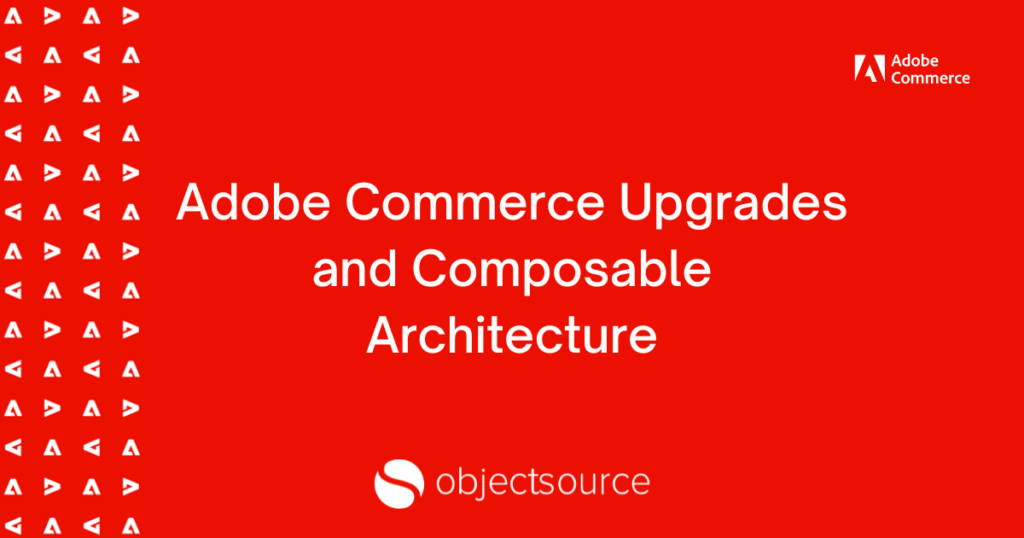
Have you ever struggled with cumbersome Adobe Commerce upgrades? You’re not alone. But what if updates could be simpler, faster, and more economical?
This post, based on insights from Adobe Principal Solutions and Enterprise Architect, Stephen Garner, reveals how composable architecture unlocks a smoother upgrade experience for Adobe Commerce merchants.
Contents:
- Challenges with upgrades in Adobe Commerce
- Adobe’s response to platform gaps
- Streamlining with composable solutions
- What is composability?
- Adobe’s approach to composability
- Supporting Magento Open Source
- The pitfalls of monolithic solutions
- Embracing flexibility with Adobe Commerce
Challenges with Adobe Commerce upgrades
Adobe Commerce, formerly Magento, has historically been praised for its robust features but criticised for the cumbersome upgrade process.
Referred to by some as ‘Magento tax’ due to the associated cost and complexity, the challenges posed by upgrades have caused some merchants to explore alternatives. They envy the smooth sailing of automatic upgrades other platforms appear to offer and are left wondering if they are stuck in a costly upgrade cycle.
Adobe’s response to platform gaps
The history of Magento 2 entailed an overreliance on third-party extensions to be add-ins to the platform’s capabilities. Through the acquisition of Magento by Adobe, Adobe ensured that the key focus of Adobe Commerce was to embark on a journey of comprehensive evolution to merchants inside of each release cadence to drive additional value and reduced total cost of ownership. The merchant was front and centre of this approach with key feedback being taken and actioned upon through the ongoing releases of Adobe Commerce.
Significant investment has been directed towards addressing the perception of these historical gaps to minimise merchant investment and enhance merchant experiences, with a keen focus on gathering feedback from merchants and partners. This collaborative approach has resulted in a more robust and complete solution delivery, catering to diverse business needs in both B2B and B2C environments.
This commitment to continuous improvement has seen the evolution of Adobe Commerce into a more adaptable and feature-rich platform, while providing the innate ability to extend from core code into microservice architectures and drive composable maturity. Additional focus was achieved to reduce the number of upgrades per year, increase the length of support per release and continue to thin the core PHP code.
Streamlining with composable solutions
A key aspect of Adobe’s strategy in enhancing Adobe Commerce lies in the concept of composability. This approach involves two fundamental steps: augmenting platform features to cater to a wide range of scenarios and thinning out the codebase to minimise dependencies and avoid the pitfalls of a monolithic architecture.
By embracing composability, Adobe Commerce empowers merchants to extend the platform’s capabilities through included solutions, thereby simplifying the upgrade process and enhancing overall delivery of an e-commerce platform.

What is composability?
Composability, as a technological concept, revolves around the strategic separation of computationally heavy components from the core PHP codebase.
This allows merchants to leverage purpose-built architectures tailored to their specific requirements. While the core PHP platform remains intact, intensive components are transitioned into composable services, reducing dependencies and facilitating seamless upgrades.
This approach underscores Adobe’s commitment to providing merchants with choices and flexibility in optimising their e-commerce operations.
Adobe’s approach to composability
Adobe Commerce offers a broad range of composable services, from Live Search and Product Recommendations powered by Adobe Sensei, Catalog Service through to the SaaS indexing solution. Adobe App Builder and API Mesh provide microservice and API management and scalability across not just Adobe Commerce, but into a merchant’s own business systems and processes. These services are designed to minimise reliance on core PHP code, thereby simplifying the upgrade process and bolstering platform scalability and performance.
Merchants can integrate these services into their existing infrastructure as well as Adobe Commerce on Cloud for complete Adobe platform support, enhanced performance and efficiency. This flexible approach demonstrates Adobe’s dedication to delivering tailored solutions that meet the evolving needs of e-commerce businesses.
These composable services reduce reliance on the core PHP code, therefore simplifying upgrades:
- Less code, less hassle: Fewer moving parts mean smoother updates with reduced complexity.
- Easy integration: Features such as app builder and API mesh simplify integrating external systems.
Supporting Magento Open Source
While Adobe Commerce is a frontrunner when it comes to comprehensive e-commerce solutions, it remains committed to supporting the Magento Open Source community. This commitment is manifested through initiatives such as Page Builder and Adobe Payments, which aim to enhance the capabilities of Magento Open Source merchants.
By providing access to advanced features and technologies, Adobe empowers merchants to transition seamlessly from Magento Open Source to Adobe Commerce, ensuring continuity and scalability in their e-commerce efforts.
The pitfalls of monolithic solutions
Monolithic solutions, characterised by tightly integrated architectures, can pose significant challenges in terms of adaptability and scalability. Simply put, they are difficult to change.
Adobe Commerce recognises the limitations of monolithic architectures and has taken proactive measures to address these shortcomings.
By breaking down monolithic structures into smaller, more flexible services, Adobe Commerce enhances scalability, simplifies upgrades, and reduces technical debt. This shift towards a more modular and adaptable architecture aligns with industry best practices and standards for composability, whilst providing agility with composable services to be drop-ins when required by a merchant.
Embracing flexibility with Adobe Commerce
By prioritising upgrades, enhancing composability, and embracing flexibility, Adobe Commerce empowers merchants to navigate the complexities of modern e-commerce with confidence.
Through collaborative innovation and a commitment to continuous improvement, Adobe Commerce continues to set the standard for excellence in the e-commerce landscape, ensuring that merchants can thrive in an ever-changing digital environment.
Ready to ditch upgrade stress and embrace composability? Schedule a consultation to discuss your needs.
Stephen Garner is Principal Solutions and Enterprise Architect at Adobe where he leads both technical and non-technical strategic initiatives, driving transformative change within Adobe’s e-commerce landscape for both merchants and partners.


